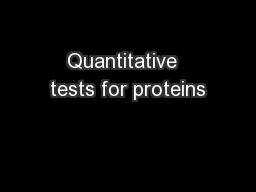PPT-Quantitative tests for proteins
Author : conchita-marotz | Published Date : 2020-04-05
Introduction Colorimetric assays allow for indirect determination of specific concentration such as proteins carbohydrates enzyme activity etc via color change
Presentation Embed Code
Download Presentation
Download Presentation The PPT/PDF document " Quantitative tests for proteins" is the property of its rightful owner. Permission is granted to download and print the materials on this website for personal, non-commercial use only, and to display it on your personal computer provided you do not modify the materials and that you retain all copyright notices contained in the materials. By downloading content from our website, you accept the terms of this agreement.
Quantitative tests for proteins: Transcript
Download Rules Of Document
" Quantitative tests for proteins"The content belongs to its owner. You may download and print it for personal use, without modification, and keep all copyright notices. By downloading, you agree to these terms.
Related Documents














